Editoral
Important Advisory to the Public as the Federal Government Lifts Ban on Interstate Travel
Posted: 30-06-2020 09:58:39 PM
The coronavirus disease (COVID-19) pandemic has had severe impacts on the economic, social, and political structures of several countries. However, various strategies have been employed to promptly detect, limit transmission, and effectively manage confirmed cases to recovery.
On the 29th of March 2020, the President of the Federal Republic of Nigeria, President Muhammadu Buhari issued a lockdown of non-essential activities in the Federal Capital Territory, Lagos and Ogun States for an initial period of time. This was also implemented by several state governments across the country as part of subnational efforts to limit the spread of the disease. However, as the pandemic continues, the lockdown is being periodically reviewed and gradually eased, adopting a phased approach, to enable the reopening of economic activities.
Based on the assessment of the dynamics of COVID-19 in Nigeria, the Presidential Task Force on COVID-19 (PTF-COVID-19) has continued to provide evidence-based recommendations to the President. This has informed public health and social measures (PHSM) including the restriction of mass gatherings; closure of schools; inter-state movement restrictions; mandating the wearing of face masks and so on by the Federal Government of Nigeria.
On the 29th of June 2020, PTF-COVID-19 announced further extension of the second phase of the lockdown characterised by the following:
1. Lifting the existing ban on interstate travel. Only outside curfew hours (10 p.m. – 4 a.m.)
2. Safe reopening of schools only for students in graduating classes to enable preparation for examinations
3. Safe resumption of domestic flight service as soon as practicable
4. Reduction in the sitting capacity for public transport sector by 50%
5. Continuous observation of existing recommended precautionary measures. This includes mandatory use of a non-medical face mask/covering for all persons while in public spaces; mandatory provision of handwashing facilities/sanitisers in all public places, etc.
These will take effect from the 30th of June till the 27th of July 2020 when a further review will be done. While we commend all Nigerians for their compliance thus far, we wish to remind all that community transmission is still ongoing. Therefore, we urge the public to keep adhering to the afore-mentioned measures and take responsibility in the fight against the disease. The Nigeria Centre for Disease Control will continue to provide evidence-based guidelines for Nigerians as the country gradually resumes social and economic activities.
Summary of Incidents
Notes
1. Information for this disease was retrieved from the Technical Working Group and Situation Reports
2. Case Fatality Rate (CFR) for this disease is reported for confirmed cases only
3. Information for this disease was retrieved from IDSR 002 data
4. CFR for this disease is reported for total cases i.e. suspected + confirmed
5. Information for sentinel influenza was retrieved from the laboratory
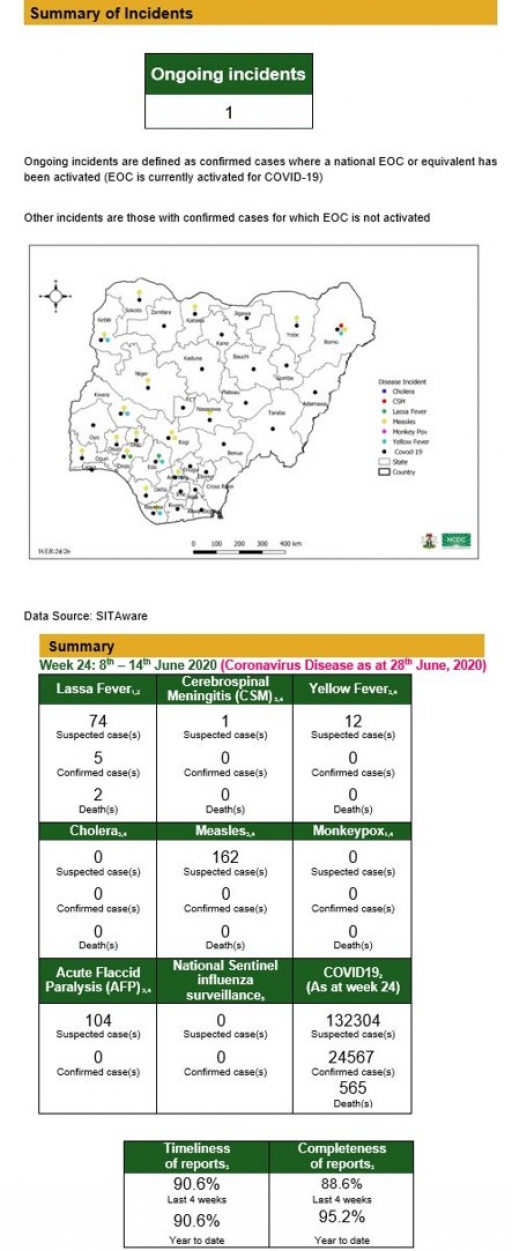
Lassa Fever
Key points
• There were 74 suspected cases, five laboratory confirmed cases and two deaths were recorded from three LGAs in two states
Actions
To date:
• National Lassa fever multi-partner, multi-sectoral Technical Working Group (TWG) continues to coordinate the response activities at all levels
Planned:
• Continue surveillance and resource mobilisation

Cerebrospinal Meningitis (CSM)
Key points
There was one (1) suspected case of Cerebrospinal Meningitis (CSM) reported from Gwoza LGA in Borno state. It was not laboratory confirmed and no death was recorded
Actions
To date:
• National CSM TWG meets weekly to review reports from states and plan appropriately
• Enhanced surveillance in all states
Planned:
• Continue harmonisation of the national line list and SORMAS data
• Continue to ensure that states reporting cases send their line lists and collect CSM samples
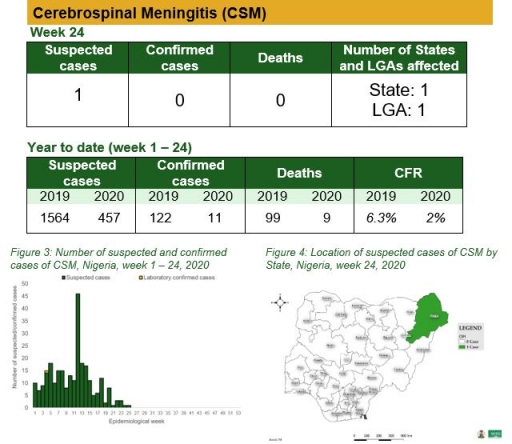
Yellow Fever
Key points
• There were 12 suspected cases of Yellow Fever (YF) reported from 12 LGAs in five states. None was laboratory confirmed and no death was recorded
Actions
To date:
• National multiagency YF Technical Working Group (TWG) is coordinating response activities
Planned:
• Continue harmonisation of surveillance and laboratory data
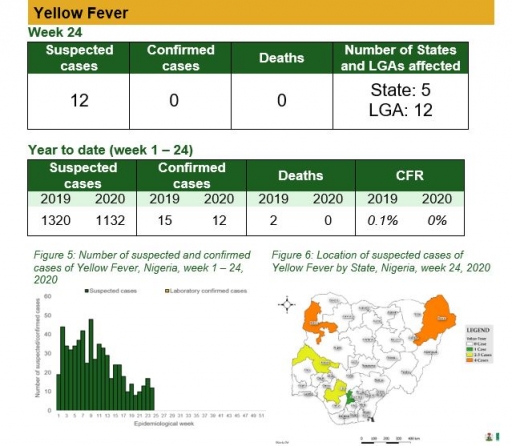
Cholera
Key points
• There was no case of cholera reported this week
Actions
To date
• National Cholera Multi-Sectoral Technical Working Group (TWG) is monitoring all states and supporting already affected states
Planned:
• Continue follow up and monitoring of non-reporting states
• Continue harmonisation of the national line list and SORMAS data
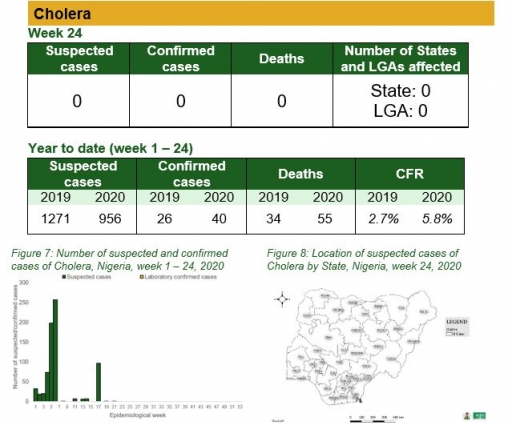
Measles
Key points
• There were 162 suspected cases of measles reported from 44 LGAs in 15 states. None was laboratory confirmed and no death was recorded
Actions
To date
• National Measles TWG is closely monitoring measles surveillance data and providing feedback to relevant agencies and development partners
• Weekly surveillance and laboratory data harmonisation ongoing
Planned:
• Sustain monthly measles surveillance data review
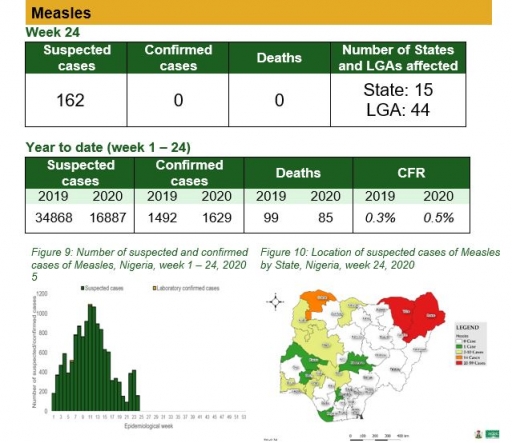
Monkeypox
Key points
• There was no case of monkeypox reported this week
Actions
To date
• National Monkeypox Technical Working Group (TWG) is monitoring activities in all states
Planned:
• Enhance surveillance for monkeypox in high burden states
• Continue harmonisation of the national line list and SORMAS data
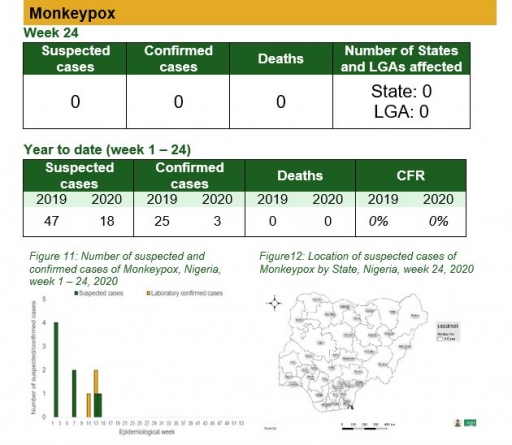
Acute Flaccid Paralysis (AFP)
Key points
• There were 104 suspected cases of AFP reported from 86 LGAs in 29 states and FCT. None was laboratory confirmed and no death was recorded
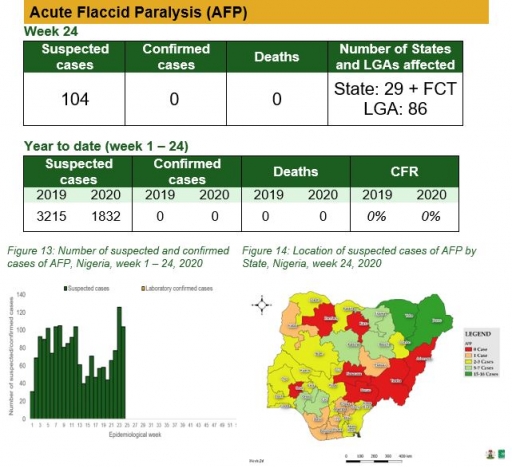
Coronavirus Disease (COVID-19)
Actions
To date:
• National COVID-19 multi-partner Emergency Operations Centre (EOC) continues to coordinate response activities across states
• A total of 37 National Rapid Response Teams have been deployed and continues to support affected states
• Developed new graphics for COVID-19 symptoms and guidelines on re-opening of religious centres
Planned:
• Finalise the review of contact tracing guidelines
• Finalise protocol for expansion of influenza sentinel sites and include COVID-19 testing
• Training of Trainers for state teams on contact tracing and active case search
• Operationalisation of COVID-19 testing in GeneXpert sites
• Deployment of mortality audit teams to states
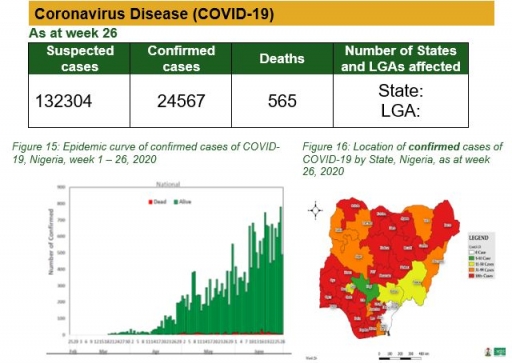
National Influenza Sentinel Surveillance
Key points
• The subtypes A seasonal H3, 2009A/H1N1 and A/not subtyped account for 0 (0.0%), 2 (9.5%) and 19 (90.5%) of the total influenza A positive sample respectively. The subtypes B VICTORIA, B Not subtyped and B Yamagata account for 0 (0.0%), 8 (100%) and 0 (0.0%) of the total influenza B positive samples respectively.
• The percentage influenza positive was highest in week 10 with 40%.

Timeliness and Completeness of Reports

Timeliness and Completeness of Reports by State
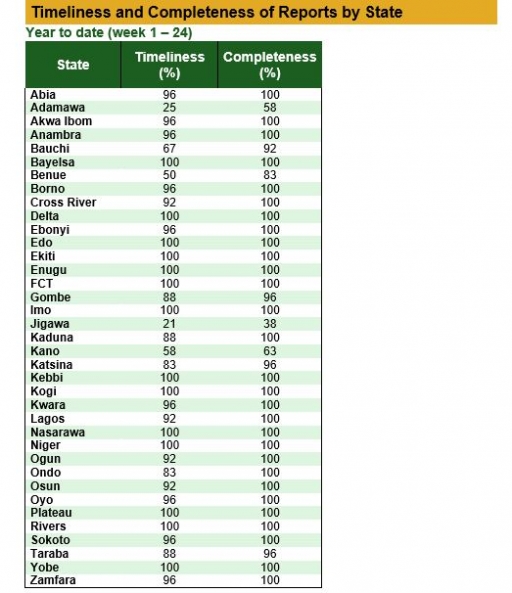














 Toll Free Number: 6232
Toll Free Number: 6232 Whatsapp: +234 708 711 0839
Whatsapp: +234 708 711 0839 SMS Number: +234 809 955 5577
SMS Number: +234 809 955 5577 